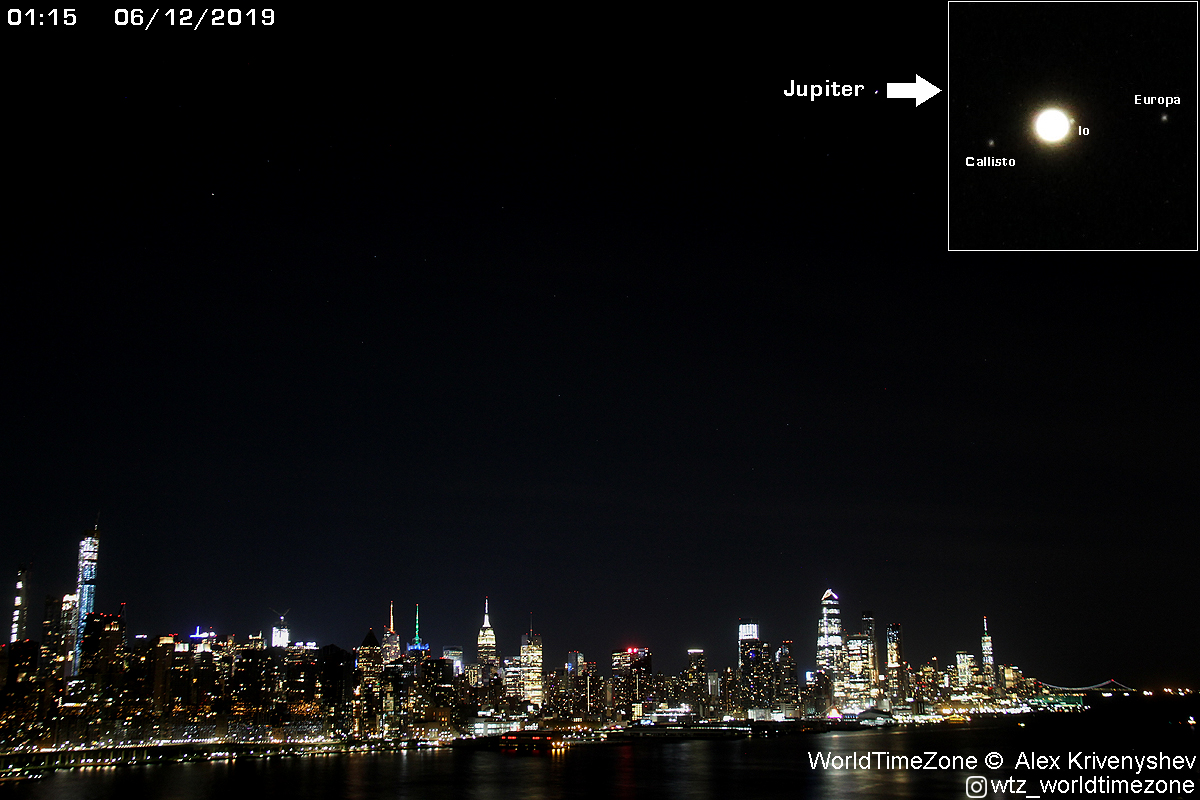
Jupiter is putting on such a good sky show right now that it stands out above the glittering lights of New York City.
Skywatcher Alexander Krivenyshev of WorldTimeZone.com captured some gorgeous shots of Jupiter blazing over the Big Apple early Wednesday morning (June 12), the same day that the king of planets made its closest approach to Earth in 2019.
Some of the photos, which Krivenyshev took from the New Jersey city of West New York, also show Callisto, Io and Europa — three of Jupiter's four famous Galilean moons, which are so called because they were discovered by Italian astronomer Galileo Galilei. (The fourth one is Ganymede, the largest moon in the solar system.)
Related: Night Sky, June 2019: What You Can See This Month (Maps)
You can pick out those moons yourself these days, if you have clear skies, some patience and a decent pair of binoculars. That's because Jupiter is so big, so bright and so close.
On Wednesday, the king of planets got within 398 million miles (641 million kilometers) of Earth, according to EarthSky.org, the closest the two planets get to each other all year. The milestone came two days after Jupiter's opposition — when the sun, Earth and Jupiter are all lined up, with Earth in the middle.
Closest approach and opposition are not perfectly synched up because the orbits of both Jupiter and Earth are slightly elliptical and on slightly different planes, EarthSky.org explained.
Get the Space.com Newsletter
Breaking space news, the latest updates on rocket launches, skywatching events and more!
Jupiter and Earth are now getting farther apart, but the gas giant will remain a bright fixture in our night sky for the next few months (though it hangs relatively low from the perspective of an observer at midnorthern latitudes).
Indeed, there's a good viewing opportunity involving the moon and Jupiter Sunday night through Monday morning (June 16 and June 17), as Space.com skywatching columnist Joe Rao explained in his June night-sky guide.
"At sundown on June 16th, look low toward the east-southeast horizon for the rising moon, and situated prominently about 4 degrees to its upper right will be Jupiter," Rao wrote. "At around midnight, Jupiter will appear to the right of the moon, and the gap between them will have widened to 6 degrees. By around 5 a.m., Jupiter is just about to set, with the moon now standing 8 degrees to its upper left."
(Your closed fist held at arm's length covers about 10 degrees.)
Editor's note: If you have an amazing night-sky photo you'd like to share with us and our news partners for a possible story or image gallery, please send images and comments in to spacephotos@space.com.
- Photos: Jupiter, the Solar System's Largest Planet
- June New Moon 2019: Catch Planets and Constellations in the 'Moonless' Sky
- Spectacular Time-Lapse Video Shows Wonders of the Night Sky
Mike Wall's book about the search for alien life, "Out There" (Grand Central Publishing, 2018; illustrated by Karl Tate), is out now. Follow him on Twitter @michaeldwall. Follow us on Twitter @Spacedotcom or Facebook.
Join our Space Forums to keep talking space on the latest missions, night sky and more! And if you have a news tip, correction or comment, let us know at: community@space.com.

Michael Wall is a Senior Space Writer with Space.com and joined the team in 2010. He primarily covers exoplanets, spaceflight and military space, but has been known to dabble in the space art beat. His book about the search for alien life, "Out There," was published on Nov. 13, 2018. Before becoming a science writer, Michael worked as a herpetologist and wildlife biologist. He has a Ph.D. in evolutionary biology from the University of Sydney, Australia, a bachelor's degree from the University of Arizona, and a graduate certificate in science writing from the University of California, Santa Cruz. To find out what his latest project is, you can follow Michael on Twitter.









